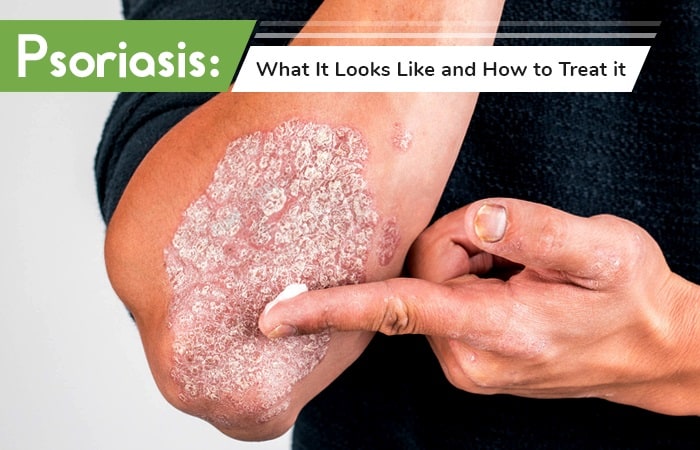
When you think of psoriasis, you probably think of a skin condition that causes bumpy patches, right? Well, did you know that psoriasis goes deeper than the skin? It’s actually a chronic autoimmune condition that is to blame for the itchy, scaly skin patches. Not only does this condition cause self-image issues, but it can cause emotional issues too. But, if you have psoriasis, you aren’t alone. About 7.5 million people in the United States suffer from the condition. While there isn’t a cure for psoriasis, there are ways to prevent flare-ups. The skin experts at Winston-Salem Dermatology can help you understand what you’re dealing with and get you started on the right path for smoother skin.
What Causes Psoriasis?
Psoriasis causes the skin to regenerate more quickly than normal. Usually, new skin cells will take about a month to rise to the surface of the skin, but with psoriasis it only takes days. So, the bumpy skin you see is skin cells that rise too fast and pile up on the skin.
Experts aren’t exactly sure what causes someone’s immune system to work this way. But genetics and environmental factors are believed to play a role. The most important thing to know about Psoriasis is that it is not contagious. While the red patches look like a rash that could rub off on someone, there’s no need to avoid being around someone when you have a flare-up.
What Does Psoriasis Look like?
There’s no exact location for where psoriasis can show up, because it can appear anywhere you have skin. Because each area of skin is different, the location where your psoriasis pops up will require different treatments. Here are the most common locations for psoriasis to appear on the body and what it usually looks like:
Elbows and Knees
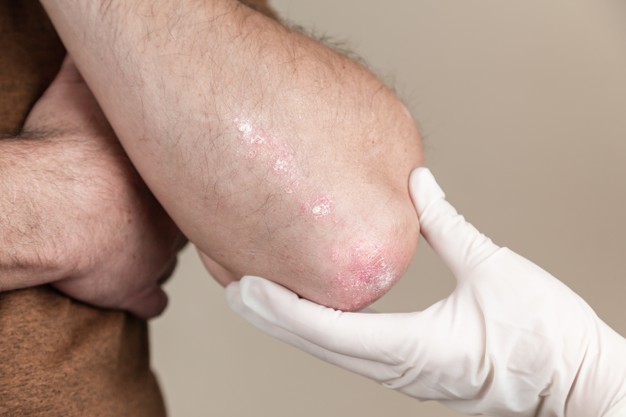
This is the most common area for psoriasis to show up. They are often itchy and painful when they appear in these areas and can crack and can bleed.
Scalp
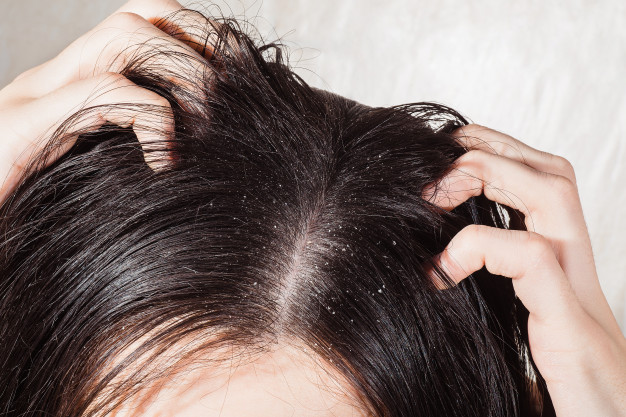
This is another pretty common area for psoriasis. They can range from mild to slight scaling, but they can also have thick scales and show up all over the entire scalp. In some cases, the plaque psoriasis can go onto their forehead, down the back of the neck, and even appear around the ears.
Face

Although psoriasis on the face isn’t as common, it can still happen. When someone does get psoriasis in this area, it usually happens in the eyebrow area, the skin between their nose and upper lip, the area in the upper forehead, and around their hairline.
Hands and Feet
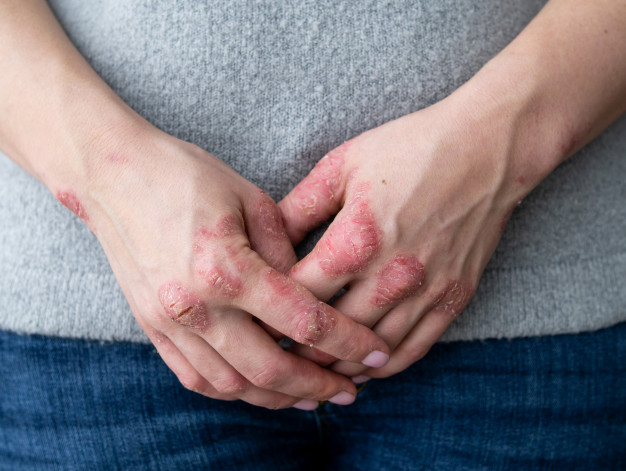
This is known as palmar-plantar psoriasis. When psoriasis appears on your hands or on the soles of your feet, it is usually scaly and sometimes blistered or red.
Nails
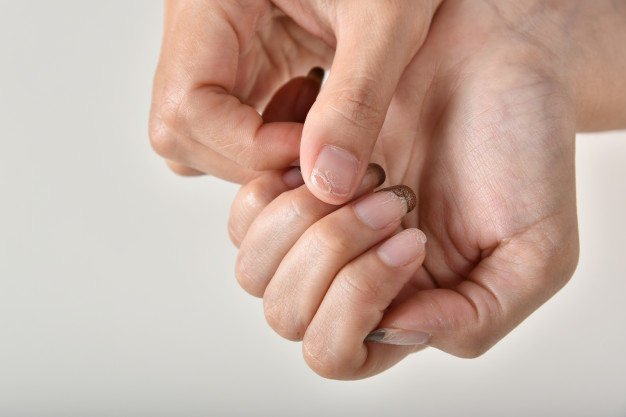
About 50 percent of people with psoriasis see changes to their fingernails. And that number jumps to 90 percent in those with psoriatic arthritis. The nails have a yellowish discoloration and can sometimes lift the nail plate off the nail bed.
Genitals
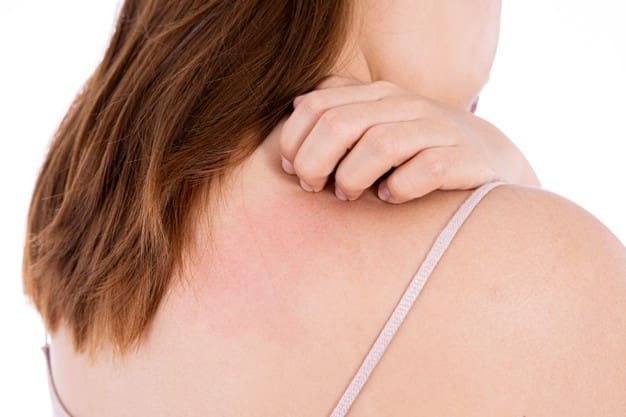
Psoriasis can even show up in the folds of your skin in the genital area. This usually looks smooth and shiny, with a waxy appearance.
Skin Folds
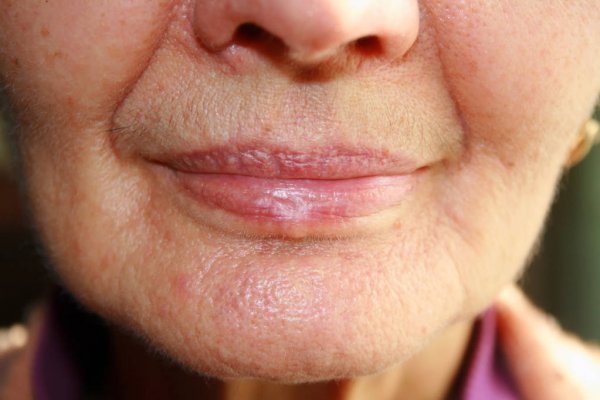
Skin folds around the genitals aren’t the only folds where psoriasis can show up. The red lesions can also appear in the folds behind the knees, between butt cheeks, and under the breasts.
What You Should Know About Psoriasis?
Although psoriasis isn’t contagious, it’s a condition that should be taken seriously. The impact of the scaly, itchy skin can range from annoying to life-altering, depending on their location. Here are some things you may not know about the condition, but you should:
• Psoriasis is an inflammatory skin condition diagnosed by a physician
Patients are typically diagnosed with psoriasis in their 20s or later on as an adult. A dermatologist will be able to diagnose your psoriasis with a clinical examination, looking at your family history, and sometimes taking a skin biopsy.
• Psoriasis is not the same as eczema
Eczema is another skin condition, and it’s often confused with psoriasis. Eczema, or atopic dermatitis, develops in early childhood, unlike psoriasis that forms later in life. Compared to psoriasis, eczema tends to be itchier and not as well-defined as psoriasis. Psoriasis has sharper borders and thicker scaling.
• Psoriasis is not contagious
Your family, friends, and strangers may be scared to get close to you because they may worry they will catch your psoriasis. But, here’s the good news, it’s not contagious at all.
• Psoriasis treatments have improved greatly in the last decade
Doctors are starting to understand psoriasis more now than ever before. This makes psoriasis face treatment, nail psoriasis treatment, guttate psoriasis treatment, and other forms of psoriasis easier to treat. Treatment options range depending on the extent of the condition. Most psoriasis treatment works by targeting inflammation that’s caused by the immune system. Topical steroids, emollients, and phototherapy can all be used as outpatient treatment options.
• Psoriasis can run in families
If you have family members that have psoriasis, there’s a good reason that’s why you have psoriasis too. Genetics seems to be one of the biggest risk factors for developing psoriasis.
• Depression is common
If you have psoriasis and you have depression, you aren’t alone. Depression is actually pretty common for psoriasis patients. Because psoriasis is such a visible disease, it’s hard to hide and can cause embarrassment, which can lead to depression. Most patients say their depression symptoms improve after their psoriasis symptoms get better. Some patients also feel better after getting therapy for their mental health.
• Stress reduction is a key part of psoriasis treatment
Cutting out stress can cut out flare-ups. Doctors say that while topical creams or other medications for your psoriasis are important in preventing flare-ups, so is stress reduction.
What is the Best Treatment for Psoriasis?
While psoriasis is a lifelong condition, there are various treatments that can help reduce symptoms. Most treatments work by targeting inflammation. Here are the most common ways you can get relief from your psoriasis:
1) Topical drugs
In some cases, topical drugs are given to treat surface areas that have psoriasis. This is for areas where less than 5% of the area is impacted. Topical drugs aren’t used for hands, feet, or genitalia.
2) Phototherapy
This is used for moderate to severe cases of psoriasis. Phototherapy combines ultraviolet B (UVB) and UVA light treatments. Sometimes this therapy can be combined with prescription drugs or topicals.
3) Disease-modifying antirheumatic drugs
These are drugs used for aggressive treatment to help slow down inflammation. This includes methotrexate and cyclosporine.
4) Biologic drugs
These drugs can be used to treat severe plaque psoriasis. The drugs block certain cells or proteins that can play a role in psoriasis. Some biologic drugs are shots under the skin that you can give yourself at home. Others are given by an IV at your doctor’s office.
Psoriasis Treatment with the Triad’s Leading Skin Care Team
If you think you have psoriasis, talking to your doctor is the key. Psoriasis is a lifelong disease, but that doesn’t mean you have to suffer from it. There are several different nails, elbow, face, and scalp psoriasis treatment options. No matter where your psoriasis is, we have a team of experts that can diagnose and design a treatment plan for you. Your skin is our passion, and we are here to help. So, don’t put up with your psoriasis any longer. Call Winston Salem Dermatology today at (336) 774-8636 to get started.

